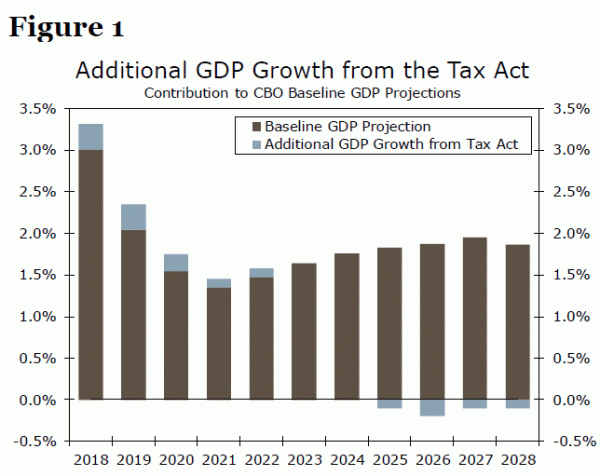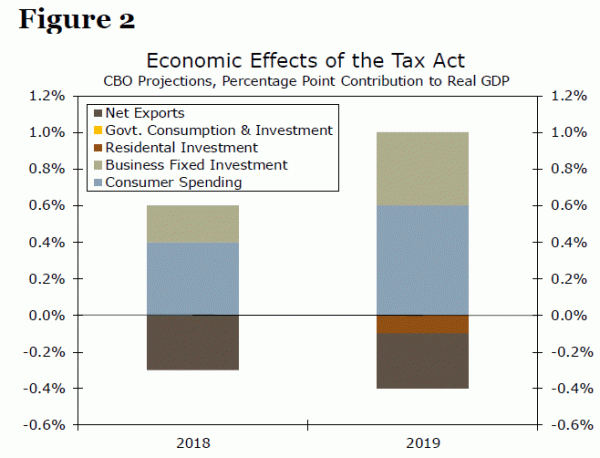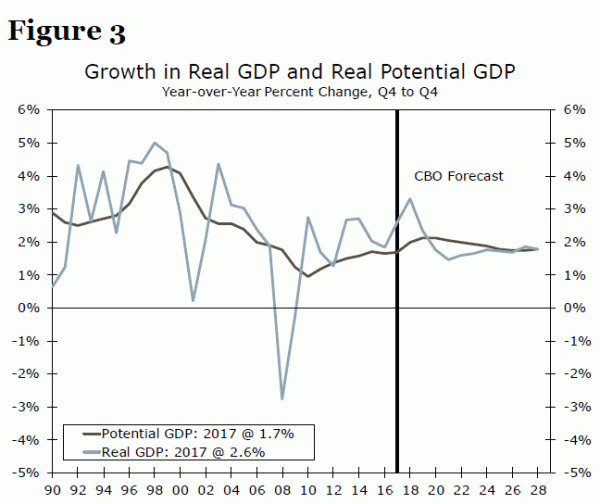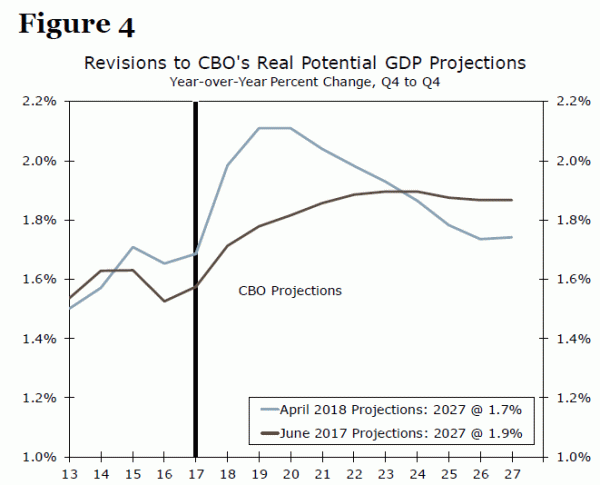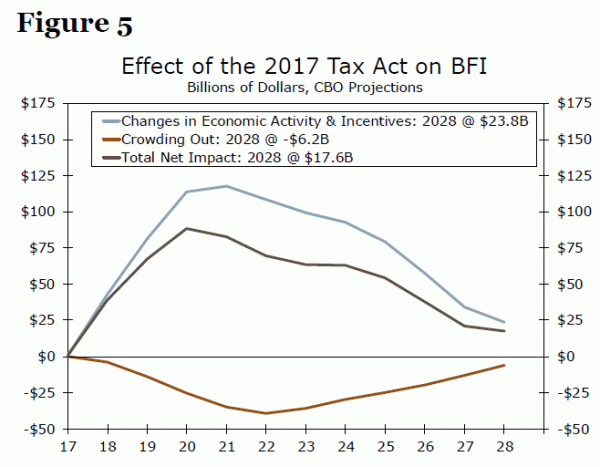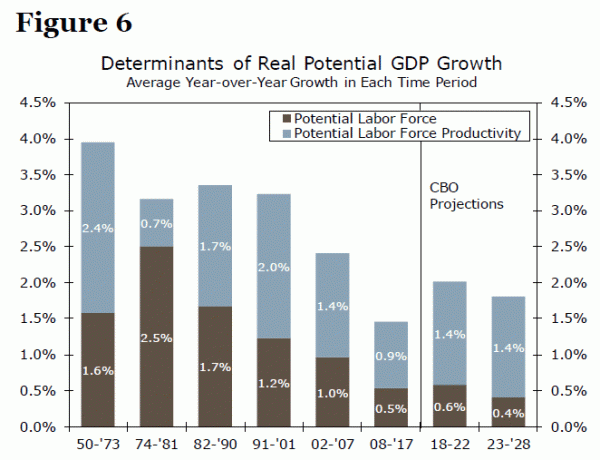Executive Summary
Fiscal stimulus has been one of the key drivers of our outlook for faster economic growth this year, with the recently enacted Tax Act playing a major role.1 Over the course of 2017 as the tax bill was taking shape, we were asked three questions regarding the tax plan the most often: what will be the short-run economic impact, what will be the long-run economic impact and how much will the plan cost? Now that the Joint Committee on Taxation (JCT) and the Congressional Budget Office (CBO) have had some time to do a more thorough review of the 2017 tax act, this report reexamines the short-run and long-run effects as measured by the official scorekeepers.2
We find that the updated estimates of the Tax Act’s impact on near-term economic growth are roughly in line with our original expectations for an additional 0.2 percentage points on year-overyear GDP growth in 2018 and 0.3 percentage points in 2019, with most of that boost to growth stemming from higher consumer spending. Over the next few years, CBO expects greater labor force participation and more capital deepening to help drive a modest acceleration in potential GDP. However, “crowding out” from bigger deficits and the temporary nature of some of the plan’s provisions limit the gains in potential GDP over the long-run. After accounting for economic feedback effects, CBO estimates that the Tax Act will increase deficits by $1.9 trillion over the next 10 years relative to previous law. That estimate assumes that all temporary provisions are allowed to expire as is the case under current law. Similar to CBO, we remain skeptical that the acceleration in the economy will be significant enough to offset the deep fiscal hole the United States faces in the years ahead. In light of this assessment from CBO and our own analysis, we remain concerned about fiscal policy’s flexibility to respond to an economic slowdown, should one occur sometime over the next decade.
Short-Run Impact: Which Sectors of the Economy Are Most Affected?
In the immediate aftermath of the Tax Act’s release, the JCT produced an economic impact analysis which showed that the act would increase the level of GDP over the next 10 years by 0.7 percent on average.3 In CBO’s annual Budget and Economic Outlook, CBO dives into more detail regarding the way in which GDP growth, inflation and interest rates were adjusted in its baseline due to the tax policy changes.
Our conclusion for the tax package after taking into consideration JCT’s score was that real GDP growth would be 0.2 and 0.3 percentage points higher in calendar years 2018 and 2019, respectively, with most of these effects coming from stronger consumer spending.4 CBO’s more detailed analysis released in April shows that their baseline economic growth forecast of 3.0 percent in 2018 and 2.9 percent in 2019 is 0.3 percentage points higher in both years due to the Tax Act (Figure 1). Within its baseline forecast, CBO expects real consumer spending and real business fixed investment (BFI) to be larger by 0.4 percent and 0.2 percent, respectively, in 2018 as a result of the tax bill. Offsetting some of this growth in 2018 is a drag from net exports as imports increase to service the higher domestic demand and exports pull back due to a strengthening U.S. dollar (Figure 2). The story is only slightly more nuanced in 2019, as real consumer spending and business fixed investment strengthen further, with the growth effects being partially offset by a widening in the trade deficit. In CBO’s view, reduced tax incentives related to the housing market result in the tax bill generating a very slight drag on residential investment in 2019. In total, CBO expects the size of the economy in inflation-adjusted terms will be about 0.6 percent larger as a result of the tax bill by the end of 2019.
The increase in real GDP growth in the near term is also expected to result in slightly higher inflation over the next couple of years. While the near-term inflation effects as projected by CBO are quite small in 2018 and 2019, higher inflation expectations are likely to influence business and consumer spending. The expected higher path of inflation also results in some minor reductions to the real growth effects of the Tax Act as the higher prices erode the purchasing power of consumers and businesses.
As a result of the increase in GDP growth and inflation expectations, CBO increased its estimate of the path of the federal funds rate 0.1 percentage points in 2018 and 0.2 percentage points by 2019. With the higher fed funds rate, CBO projects that the three-month T-bill rate will be 0.2 percentage points higher in both 2018 and 2019 as a result of the FOMC’s response to the stronger growth and inflation resulting from the Tax Act. In addition, CBO added 0.3 percentage points for 2018 and 0.2 percentage points for 2019 to its baseline forecast for the 10-year U.S. Treasury yield. This higher interest rate environment (besides the aforementioned inflation) offsets some of the positive effects of the Tax Act on real economic growth as the higher rates increase the cost of credit. As we will address in the next section, the longer-run effects of the Tax Act also contain some adverse effects on the economy due to the fact that the Tax Act is not deficit neutral.
Long-Run Impact: Has There Finally Been a Structural Break?
What is the economic outlook beyond the next couple years as a result of the recent tax bill? After all, the professed goal of tax reform was not just to generate a short-run sugar high in the economy but to alter the long-run growth trajectory of the economy. CBO produces what is arguably the gold standard estimate for potential GDP growth, or the long-run pace of growth that the economy can sustainably maintain. It is labor force growth and the growth in the productivity of these workers that determines the potential growth rate for the economy. The latter half of this duo can further be divided into two drivers: capital (the physical tools utilized by the workers) and total factor productivity (the intangibles that affect output per hour worked, such as education or new innovations).
The tax package could lift potential growth by increasing labor force participation/hours worked, driving more capital investment or spurring technological innovations. Conversely, however, some aspects of the tax package are likely to act as a headwind on potential growth: the temporary nature of some of the changes create inherent uncertainty, and the borrowing required to pay for the cuts will drive a “crowding out” effect. Crowding out occurs when an increase in the federal budget deficit leads more national savings to be used to buy Treasury securities rather than to fund private investment. As illustrated in Figure 3, CBO expects potential GDP to accelerate modestly in the next few years as individuals and businesses respond to stronger incentives to participate in the labor market and invest. Actual GDP growth runs above potential growth for a few years before the stimulus effect begins to fade, driving real GDP growth below potential growth after 2020 before potential growth and actual growth eventually converge, as is CBO’s standard practice in the out years of its 10-year forecast.
Yet, the acceleration in potential GDP is relatively modest, and tops out at just a bit more than 2 percent over the next couple years before slowing once again. And, while potential growth is faster over most of the next decade compared to CBO’s projections from before the tax bill, by 2027 CBO expects potential growth to be slower than it anticipated in its June 2017 estimates (Figure 4). Why is this the case? And why aren’t the potential growth upward revisions more aggressive?
The answer to both of these questions is best viewed through an example. Figure 5 illustrates CBO’s projections of how the tax bill will affect BFI spending over the next decade. More investment spending drives capital deepening, boosting output per hour worked (labor productivity). The tax bill leads to stronger BFI through two channels: by lowering the user cost of capital and thus increasing the incentive to invest, and by boosting aggregate demand, which prompts businesses to invest in capital to meet that additional demand. CBO’s estimate of the magnitude of these changes is illustrated in Figure 5.
Two factors, however, offset the faster growth seen in BFI between 2017 and 2020. First, the crowding out effect discussed earlier makes the net effect on BFI smaller (Figure 5). As has been illustrated recently, increased borrowing needs from the government push up market interest rates, creating a partially offsetting upward pressure on the user cost of capital for private borrowers. Second, while most of the expiring tax provisions are on the individual side of the tax code, there are also expiring provisions on the business side. For example, the “full expensing” provision, which allows companies to immediately deduct 100 percent of a new investment, begins to phase out starting in 2022. Perhaps this provision and others that are temporary in nature will be extended when the time comes, but this would likely then lead to even more borrowing and a larger crowding out effect than is currently in the baseline. The end result would likely be modestly faster potential growth than in CBO’s baseline, but also more debt.
All long-term projections are inherently uncertain, and CBO readily admits that “the long-term economic effects of the 2017 tax act are particularly uncertain.” But even if potential growth was to rise to the projected peak of 2.1 percent and hold at that pace rather than slow as CBO expects, it would still be well shy of what the United States has experienced over the past half-century, primarily due to demographic headwinds from an aging population (Figure 6). In our view, the implications of this outlook are two-fold. First, even with the faster growth brought on by the tax bill, the policy change will not be enough for the United States to grow its way out of the fiscal hole it faces over the next decade. Second, although CBO does expect potential growth to be faster in the next decade than in the previous one, it remains relatively subdued by historical standards. As a result, the slower growth/slower inflation/lower interest rate environment that has prevailed since the Great Recession may only see a modest reversal in the decade ahead, barring some major exogenous shock to productivity growth. Our current forecast for three percent real GDP growth in 2018 should not be mistaken for a structural break from the underlying headwinds weighing on potential growth in the United States.
Updated Cost Estimate: What’s a Few Trillion Dollars Among Friends?
The CBO and JCT initially scored the Tax Act, including economic feedback effects, as an increase in the cumulative deficit of about $1 trillion over the next 10 years, before accounting for the effects on debt service costs. In CBO’s Budget and Economic Outlook, the comparable cost estimate was revised significantly higher to $1.3 trillion. After tacking on the estimated debt service costs associated with the higher deficits, CBO projects the grand total will come to $1.9 trillion over 10 years after accounting for macroeconomic feedback effects. The larger expected deficit stems primarily from a different set of economic assumptions between the initial JCT score and the CBO score, which includes more up-to-date economic information.5 Even more concerning, however, is the estimated effect of making the individual tax cuts, which are set to expire in 2025, permanent.
Were this to occur, CBO estimates that cumulative federal deficits would rise an additional $1.2 trillion over the next decade, mostly due to lost revenues.6
As we discussed in the long-run section above, the concern is that even more U.S. debt issuance, should some or all of the temporary tax provisions be extended, would further crowd out private investment. This in turn would diminish the long-run macroeconomic benefits of making the temporary tax cuts permanent, although the effect would of course vary depending on the specific provisions extended.
These macroeconomic effects in both the short and long run highlight the complex interactions of engaging in fiscal policy expansion when the output gap is essentially closed and actual GDP growth is above potential GDP growth. Optimists might argue that growth may end up being much faster than expected over the next decade, making the fiscal costs less burdensome than currently believed. While this is certainly a possibility, it is worth remembering that the tail risks to this line of reasoning are two sided. Economic growth may be weaker than expected, which would lead to even more severe fiscal deterioration, all else equal.
Broadly speaking, it appears the Tax Act has brightened the prospect for near-term economic growth in the United States, both on the demand side and on the supply side. Subsequently, the outlook for several other economic variables, such as potential growth and interest rates, has also risen. However, the fiscal challenges brought on by an aging population and endlessly rising health care costs remain in place, and rising interest rates will present debt servicing challenges given that the federal government’s debt-to-GDP ratio already stands at its highest level since 1950. These challenges raise questions about the economic outlook beyond the next few years: will policymakers eschew or scale back fiscal stimulus during the next downturn due to already large deficits? If tax increases and/or spending cuts must be enacted at some point in the future to deal with rising deficits and debt, will that decrease potential growth and thus lower the neutral interest rate even further? These are long-run implications of the tax bill that concern us, but only time will tell, and as John Maynard Keynes once famously proclaimed “in the long run we are all dead.”
1 In this report, we use the term Tax Act to reference P.L. 115-97. An Act to provide for reconciliation pursuant to titles II and V of the concurrent resolution on the budget for fiscal year 2018.
2 The short and long run economic effects cited throughout this report are from Congressional Budget Office. (April 2018). The Budget and Economic Outlook: 2018 to 2028. Appendix B: The Effects of the 2017 Tax Act on CBO’s Economic and Budget Projections.
3 Joint Committee on Taxation. (Dec. 22, 2017). Macroeconomic Analysis of the Conference Agreement for H.R. 1, The “Tax Cuts and Jobs Act.”
4 Brown, M.A., Pugliese, M. and Kinnaman, A. (2017). Wrapping Up The Tax Package. Wells Fargo Economics Group. Available upon request.
5 For more on the effects of more updated economic assumptions on the CBO’s score of the Tax Act see Becker, B. (April 11, 2018). Where’d that $400 billion come from? Politico, Morning Tax.
6 Congressional Budget Office. (2018). The Budget and Economic Outlook: 2018 to 2028: Table 4.5, page 90.




